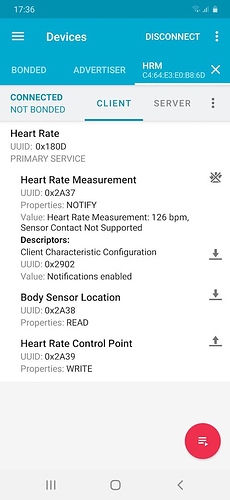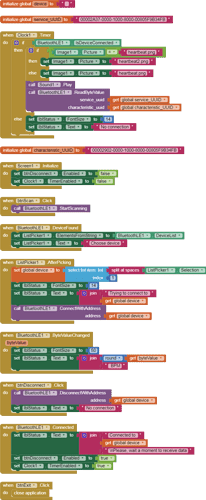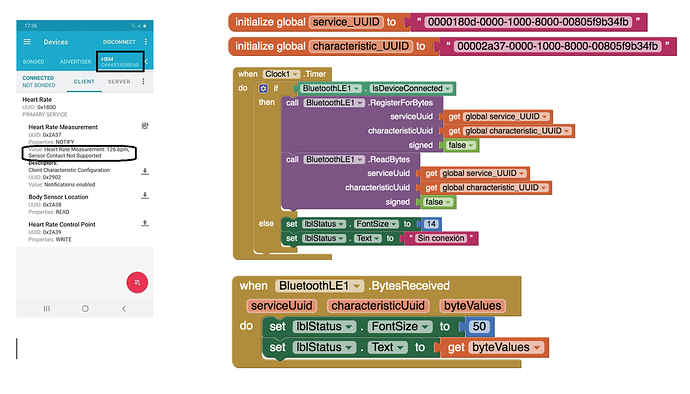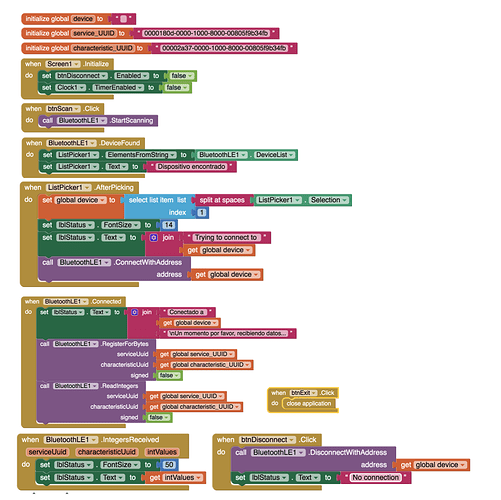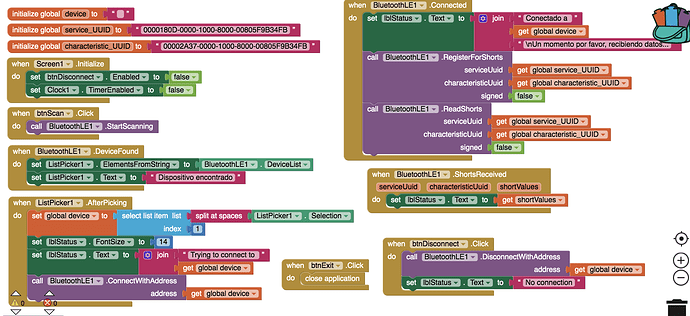Hi again and thank you very much.
HeartRateMonitor.aia (141.9 KB)
/* mbed Microcontroller Library
#include <events/mbed_events.h>
#include <mbed.h>
#include “ble/BLE.h”
#include “ble/Gap.h”
#include “ble/services/HeartRateService.h”
DigitalOut led1(LED1, 1);
const static char DEVICE_NAME[] = “HRM”;
static const uint16_t uuid16_list[] = {GattService::UUID_HEART_RATE_SERVICE};
static uint8_t hrmCounter = 100; // init HRM to 100bps
static HeartRateService *hrServicePtr;
static EventQueue eventQueue(/* event count */ 16 * EVENTS_EVENT_SIZE);
void disconnectionCallback(const Gap::DisconnectionCallbackParams_t *params)
{
BLE::Instance().gap().startAdvertising(); // restart advertising
}
void updateSensorValue() {
// Do blocking calls or whatever is necessary for sensor polling.
// In our case, we simply update the HRM measurement.
hrmCounter++;
// 100 <= HRM bps <=175
if (hrmCounter == 175) {
hrmCounter = 100;
}
hrServicePtr->updateHeartRate(hrmCounter);
}
void periodicCallback(void)
{
led1 = !led1; /* Do blinky on LED1 while we’re waiting for BLE events */
if (BLE::Instance().getGapState().connected) {
eventQueue.call(updateSensorValue);
}
}
void onBleInitError(BLE &ble, ble_error_t error)
{
(void)ble;
(void)error;
/* Initialization error handling should go here */
}
void printMacAddress()
{
/* Print out device MAC address to the console*/
Gap::AddressType_t addr_type;
Gap::Address_t address;
BLE::Instance().gap().getAddress(&addr_type, address);
printf(“DEVICE MAC ADDRESS: “);
for (int i = 5; i >= 1; i–){
printf(”%02x:”, address[i]);
}
printf("%02x\r\n", address[0]);
}
void bleInitComplete(BLE::InitializationCompleteCallbackContext *params)
{
BLE& ble = params->ble;
ble_error_t error = params->error;
if (error != BLE_ERROR_NONE) {
onBleInitError(ble, error);
return;
}
if (ble.getInstanceID() != BLE::DEFAULT_INSTANCE) {
return;
}
ble.gap().onDisconnection(disconnectionCallback);
/* Setup primary service. */
hrServicePtr = new HeartRateService(ble, hrmCounter, HeartRateService::LOCATION_FINGER);
/* Setup advertising. */
ble.gap().accumulateAdvertisingPayload(GapAdvertisingData::BREDR_NOT_SUPPORTED | GapAdvertisingData::LE_GENERAL_DISCOVERABLE);
ble.gap().accumulateAdvertisingPayload(GapAdvertisingData::COMPLETE_LIST_16BIT_SERVICE_IDS, (uint8_t *)uuid16_list, sizeof(uuid16_list));
ble.gap().accumulateAdvertisingPayload(GapAdvertisingData::GENERIC_HEART_RATE_SENSOR);
ble.gap().accumulateAdvertisingPayload(GapAdvertisingData::COMPLETE_LOCAL_NAME, (uint8_t *)DEVICE_NAME, sizeof(DEVICE_NAME));
ble.gap().setAdvertisingType(GapAdvertisingParams::ADV_CONNECTABLE_UNDIRECTED);
ble.gap().setAdvertisingInterval(1000); /* 1000ms */
ble.gap().startAdvertising();
printMacAddress();
}
void scheduleBleEventsProcessing(BLE::OnEventsToProcessCallbackContext* context) {
BLE &ble = BLE::Instance();
eventQueue.call(Callback<void()>(&ble, &BLE::processEvents));
}
int main()
{
eventQueue.call_every(500, periodicCallback);
BLE &ble = BLE::Instance();
ble.onEventsToProcess(scheduleBleEventsProcessing);
ble.init(bleInitComplete);
eventQueue.dispatch_forever();
return 0;
}


